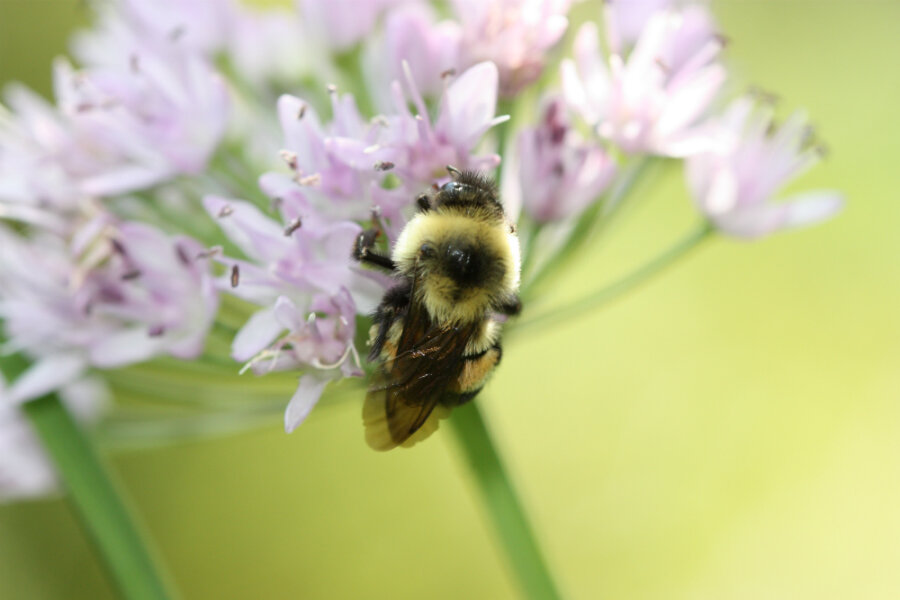Bumblebees put on endangered US species list. How to help.
Loading...
Next time you get buzzed by a bumblebee, pause before you swat.
The US Fish and Wildlife Service officially listed the rusty-patched bumblebee as an endangered species on Wednesday, a first for bees in the continental United States. With bee populations plummeting around the globe, seven species of Hawaiian bees made the list three months ago. These insects are an essential part of the ecosystem, responsible for pollinating produce and wildflowers alike.
"Pollinators are small but mighty parts of the natural mechanism that sustains us and our world," said Tom Melius, the service's Midwest regional director, according to the Associated Press. "Without them, our forests, parks, meadows and shrublands, and the abundant, vibrant life they support, cannot survive, and our crops require laborious, costly pollination by hand."
Once a common sight across 20 American states and two Canadian provinces, the rusty-patched bumblebee has been observed in only 13 states and one province since 2000. Accompanying this territorial collapse, colony counts are down almost 90 percent.
The reasons are multifold. Not only bumblebees but bee populations in general have declined precipitously in the face of a perfect storm of disease, pesticides, climate change, and habitat loss.
The decline of bumblebees has drawn increased study and concern from scientists as the species' range continues to diminish from the effects of climate change, as Joseph Dussault reported for The Christian Science Monitor in July 2015:
A new study, which tracked the upper and lower limits of North American and European bumblebee populations, found that most species are losing ground at their southern boundaries. Surprisingly, the displaced bees are also failing to extend their northern range. Lead authors Jeremy Kerr and Leif Richardson propose that this “range compression” is a result of global climate change....
“The net effect is that climate change is kind of like a vise, where [bumblebee populations] are being crushed from the southern edges of their range inward,” says Dr. Kerr, a professor of biology at the University of Ottawa.
Pesticides pose another risk to bees. An 18-year study of wild bees in England found that neonicotinoid pesticides in particular were correlated with population decline.
"The evidence against neonicotinoids now exists in key bee brain cells involved in learning and memory, in whole bees, entire colonies and now at the level of whole populations of wild bees," Christopher Connolly, a neurobiologist and bee expert told Reuters.
Fortunately for bees, businesses are taking notice. As scientific consensus regarding the potentially damaging effects of neonicotinoid pesticides grows, more and more companies are taking action, as the Monitor reported:
More than 60 retailers – including The Home Depot, Whole Foods Market, BJ's Wholesale Club, and Lowe's – have promised to phase out nursery plants that have been treated with neonicotinoid.
"The market is shifting away from selling bee-killing pesticides, and retailers including Ace Hardware and True Value are lagging behind their competitors," Tiffany Finck-Haynes, a campaigner with Friends of the Earth, told the L.A. Times.
Will such measures be enough to save the rusty-patched bumblebee? Thanksgiving dinner depends on it. In addition to the vital ecological role they play ensuring the continued production of the flowers and seeds that support animals from songbirds to bears, the bumblebee has unique economic value to humans.
According to US Fish and Wildlife, their ability to “buzz pollinate” makes them even more effective than other species, and an essential player in the farming of blueberries, cranberries, and clover. Tomatoes also depend almost exclusively on bumblebees.
Saving the rusty-patched bumblebee will be a team effort. While US Fish and Wildlife organizes top-down conservation efforts and research, gardeners can help from the ground up. Bumblebees need access to areas with flower and nectar, underground rodent holes or clumps of grass for nesting, and undisturbed soil where queens can spend the cold winter months. Anyone with a garden or lawn can help by planting native flowers and leaving some areas wild and un-mowed. You can find more details at US Fish and Wildlife’s website.
Any recovery in the bumblebee will pay dividends.
"Addressing the threats that the rusty-patched bumblebee faces will help not only this species, but countless other native pollinators that are so critical to the functioning of natural ecosystems and agriculture," said Rich Hatfield, a senior conservation biologist for the Xerces Society for Invertebrate Conservation, according to the AP.
This report contains material from the Associated Press.






